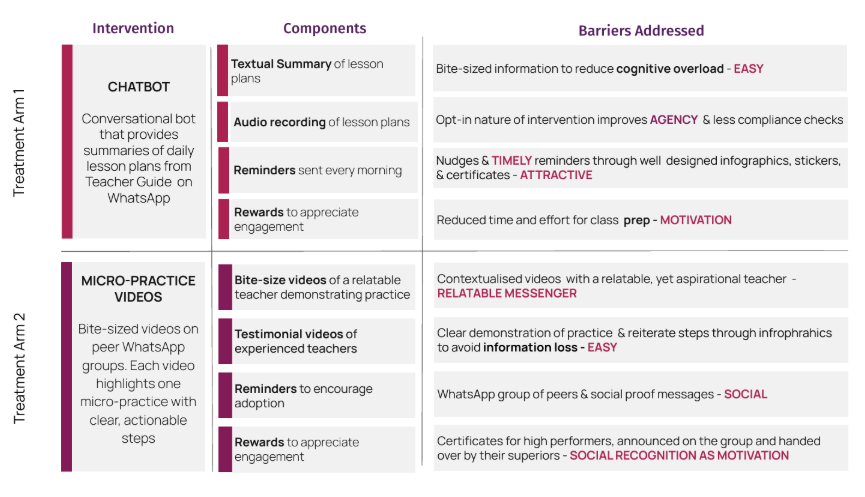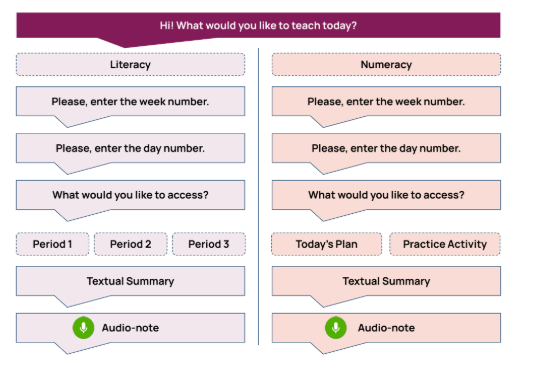- Year 2025
- Theme Education
- Team Research
Partnerships
- Central Square Foundation


India’s National Education Policy (NEP 2020) mandates that all children achieve foundational literacy and numeracy (FLN) by Grade 3. While structured pedagogy programmes—offering scripted lesson plans, workbooks, training, and mentorship—have been rolled out at scale, day-to-day adoption by teachers remains low, especially in rural government schools. Heavy administrative loads, large multi-grade classrooms, and entrenched beliefs about limits to learning further constrain uptake.
CSBC, along with Central Square Foundation, designed and tested two low-cost, WhatsApp-based strategies designed to make state-issued FLN resources and prescribed practices accessible and adoptable in two districts of UP - Sitapur and Hardoi.
We first identified barriers to adoption through qualitative discussions with teachers and government officials in three districts of Uttar Pradesh. These barriers turned out to be a mix of structural and behavioural factors. The figure below summarises the barriers, categorised thematically:

Based on insights from the diagnostic exercise and the barriers identified and prioritised, we designed and tested two low-cost, WhatsApp-based strategies aimed at making state-issued FLN resources Easy, Attractive, Social, and Timely (EAST), to improve adoption. Both strategies were designed as light-touch supports, easily accessible on mobile phones, that fit into teachers’ busy routines without adding extra administrative work.
WhatsApp Chatbot - We aimed to draw attention to the Teacher Guide, the importance and benefits of preparation/planning through bite-sized, audio-enabled summaries of daily teaching lesson plans. Regular reminders using positive deviance and social proof: habit-building prompts, streak stickers, and monthly report cards to encourage regular usage. Here, the target behaviour was the use of TG for planning and teaching.
Micro-Practice Videos (MPVs) – Providing information on micropractices through active videos that leverage emotion to inspire action, address common classroom breakdowns and demonstrate desired practice in relatable settings on peer WhatsApp groups every two weeks. Regular reminders using positive deviance and social proof: peer polls, infographics, and recognition certificates to acknowledge effort and leverage social influence. Here, the target behaviours were: a.) Teachers take student responses respectively. b.) The teacher teaches all domains of Balanced Literacy. c.) Teachers follow all steps of the Gradual Release of Responsibility in the correct order to teach a new concept in Numeracy. d.) Teachers give students dedicated time for student practice, individually and in groups, with feedback.


 We tested the impact of interventions by conducting a six-month cluster randomised controlled trial with approximately 1,900 Grade 3 teachers in rural Uttar Pradesh (Sitapur and Hardoi districts). Outcomes measured included adoption of prescribed practices, knowledge of structured pedagogy content, and valuation of teaching aids. Secondary measures included motivation, beliefs about teaching, and self-efficacy. Data were collected through self-administered surveys completed by teachers at baseline and endline.
We tested the impact of interventions by conducting a six-month cluster randomised controlled trial with approximately 1,900 Grade 3 teachers in rural Uttar Pradesh (Sitapur and Hardoi districts). Outcomes measured included adoption of prescribed practices, knowledge of structured pedagogy content, and valuation of teaching aids. Secondary measures included motivation, beliefs about teaching, and self-efficacy. Data were collected through self-administered surveys completed by teachers at baseline and endline.

No overall impact on primary outcomes for the full sample - adoption, knowledge, and valuation remained unchanged.
Light-touch digital nudges alone are insufficient to shift teaching practice at scale. For sustainable change, they should be paired with:
This project was implemented by CSBC and the Central Square Foundation, with funding from the Bill & Melinda Gates Foundation.